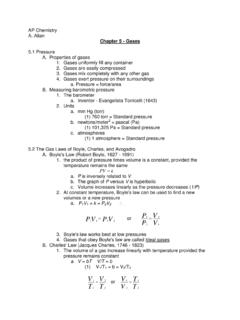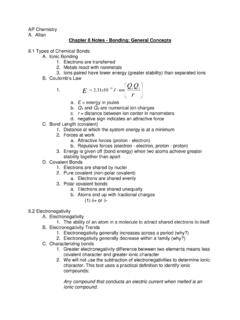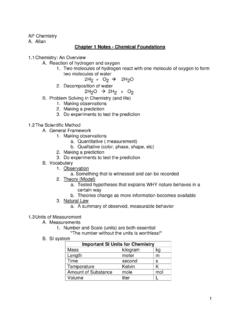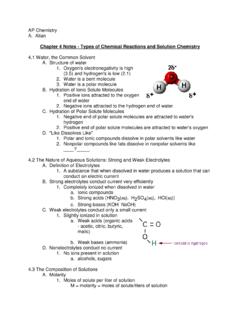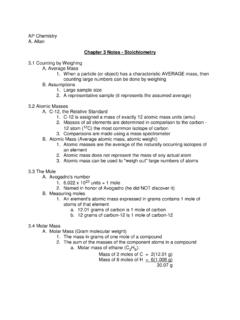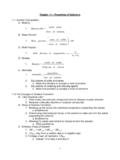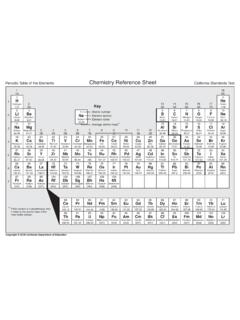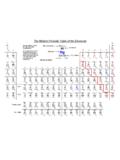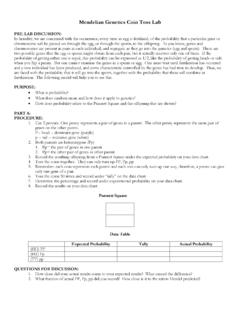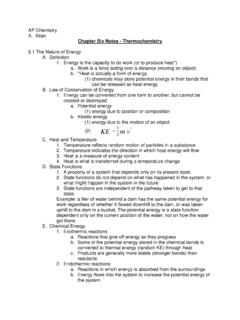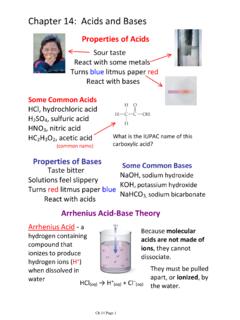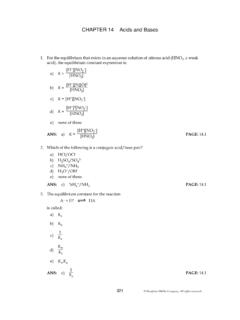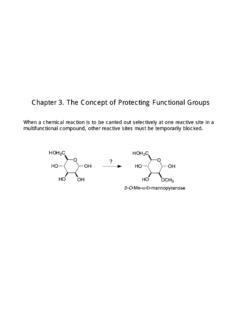Transcription of Chapter 14 - Acids and Bases - ScienceGeek.net
1 1 Chapter 14 - Acids and Bases The Nature of Acids and Bases A. Arrhenius Model 1. Acids produce hydrogen ions in aqueous solutions 2. Bases produce hydroxide ions in aqueous solutions B. Bronsted-Lowry Model 1. Acids are proton donors 2. Bases are proton acceptors 3. H3O+ is called the hydronium ion C. Conjugate acid - base Pairs 1. A conjugate base is what remains after an acid has donated a proton a. Cl- is the conjugate base of HCl 2. A conjugate acid is what is formed when a base accepts a proton base acid acid base 3. HCl is a stronger base than H3O+ (H+) so the equilibrium lies far to the right D.
2 acid Dissociation Constant 1. ][]][[HClClHKa += a. water is not included because, in dilute solution, the concentration of water is high, and changes so little it is assumed to be constant b. The dissociation constant is the same as for the dissociation equation here: HCl(aq) H+(aq) + Cl-(aq) c. Ka is used only for this type of expression d. For strong Acids such as HCl, the equilibrium lies so far to the right that [HCl] cannot be measured accurately, and an accurate calculation of Ka is not possible acid Strength A. Strong Acids 1. Acids for which the equilibrium lies far to the right a. Strong Acids yield weak conjugate Bases 2.
3 Common strong Acids a. sulfuric, hydrochloric, nitric, perchloric 2 B. Weak Acids 1. Acids for which the equilibrium lies far to the left a. Weak Acids yield relatively strong conjugate Bases C. acid Terminology 1. Monoprotic - one acidic proton 2. Diprotic - two acidic protons 3. Triprotic - three acidic protons 4. Oxyacids - Acids in which the acidic proton is attached to an oxygen atom 5. Organic Acids - Acids containing the mildly acidic carboxyl group a. Generally weak Acids b. Equilibrium lies far to the left D. Water as an acid and a base 1. Water can act as an acid or as a base a. Autoionization of water (Self-ionization) 2.
4 Ion-product constant, Kw (dissociation constant) a. At 25 C, [H+] = [OH-] = x 10-7 b. Kw = [H+][OH-] = ( x 10-7 mol/L)( x 10-7 mol/L) (1) Kw = x 10-14 mol2/L2 (units often dropped) 3. Solution characteristics a. Neutral solution, [H+] = [OH-] = x 10-7 b. acid solution, [H+] > [OH-] c. Basic solution, [H+] < [OH-] The pH Scale A. pH and pOH 1. pH = -log[H+] a. The number of decimal places in the log is equal to the number of significant figures in the original number 2. pOH = -log[OH-] 3. pH + pOH = 14 B. Solving acid and base Problems 1. Please take time to read the advice at the end of this section (Page 658).
5 It applies to far more than acid - base problems! 3 Calculating the pH of Strong acid Solutions A. What are the components of the solution? 1. HA H+(aq) + A-(aq) or HA + H2O H3O+(aq) + A-(aq) 2. H2O + H2O H3O+(aq) + OH-(aq) or H2O H+(aq) + OH-(aq) B. Focus on the major species 1. At high concentrations of strong Acids , the autoionization of water is insignificant 2. For strong Acids , the assumption is that HA is completely ionized Calculating the pH of Weak acid Solutions A. Steps (from page 662) 1. List the major species in the solution 2. Choose the species that can produce H+, and write the balanced equations for the reactions producing H+ 3.
6 Using the values of the equilibrium constants for the reactions you have written decide which equilibrium will dominate in producing H+ 4. Write the equilibrium expression for the dominant equilibrium 5. List the initial concentrations of the species participating in the dominant equilibrium 6. Define the change needed to achieve equilibrium; that is, define x 7. Write the equilibrium concentrations in terms of x 8. Substitute the equilibrium concentrations into the equilibrium expression 9. Solve for x the "easy" way; that is, by assuming that [HA]0 - x [HA]0 10. Use the 5% rule to verify whether the approximation is valid 11.
7 Calculate [H+] and pH B. The pH of a Mixture of Weak Acids 1. If one acid has a relatively higher Ka value, it will be the focus of the solution C. Percent Dissociation 1. %100)/()/( =LmolionconcentratinitialLmolndissocatio amountondissociatiPercent 2. For a given weak acid , the percent dissocation increases as the acid becomes more dilute 4 Bases A. Strong Bases 1. Group 1A metal hydroxides 2. Group 2A metal hydroxides a. Less soluble than Group 1A hydroxides; allows use as antacids B. Weak Bases 1. Ammonia and other covalent Bases 2. Compounds with low values of Kb C. Calculating the pH of Strong Bases 1. Kw = [H+][OH-] = x 10-14 a.
8 If you know [OH-], you can calculate [H+] from which you can calculate the pH D. Calculation of pOH 1. pKw = = pH + pOH 2. pOH = - pH Polyprotic Acids A. Stepwise dissociation 1. H2CO3(aq) H+(aq) + HCO3-(aq) ]][[ +==xCOHHCOHKa 2. HCO3-(aq) H+(aq) + CO32-(aq) ][]][[ +==xHCOCOHKa B. Weak Polyprotic Acids 1. Ka1 > Ka2 > C. Sulfuric acid , the Strong Polyprotic acid 1. H2SO4(aq) H+(aq) + HSO4-(aq) Ka1 is very large 2. HSO4-(aq) H+(aq) + SO42-(aq) Ka2 = x 10-2 2. Sulfuric acid dissociates to a greater extent in even its second step than weak Acids do in their first step, and the second step cannot be ignored in calculation of pH for dilute solutions of H2SO4!
9 acid - base Properties of Salts A. Salts That Produce Neutral Solutions 1. Salts that consist of the cations of strong Bases and the anions of strong Acids have no effect on pH, ([H+]), when dissolved in water 2. Cations of strong Bases a. Na+ K+ (Group 1A) 3. Anions of strong Acids a. Cl-, NO3- B. Salts that Produce Basic Solutions 1. For any salt whose cation has neutral properties and whose anion is the conjugate base of a weak acid , the aqueous solution will be basic C2H3O2-(aq) + H2O(l) HC2H3O2(aq) + OH-(aq) base acid acid base 5 C. Salts that Produce Acidic Solutions 1.
10 Salts in which the anion is not a base and the cation is the conjugate acid acid of a weak base produce acid solutions NH4+(aq) NH3(aq) + H+(aq) 2. Salts that possess a highly charged metallic ion, such as Al3+ a. Aluminum ion in water is hydrated, Al(H2O)63+ b. High metallic charge polarizes O - H bond in water c. Hydrogens in water become acidic D. Salts with Acidic and Basic ions 1. IF Ka for the acidic ion is greater than Kb for the basic ion, the solution is acidic 2. IF Kb for the basic ion is greater than Ka for the acidic ion, the solution is basic 3. IF Kb for the basic ion is equal to Ka for the acidic ion, the solution is neutral The Effect of Structure on acid - base Properties A.
